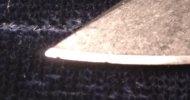Hello folks,
Some time ago I bought a Guardian 3/M390 from Bradford knives and I really like this knife, ergonomics is great. From what I heard, M390 steel excelled in almost any respect and indeed I was able to get a very sharp edge but as I dont cut cardboard or rope too often. I'd say I need to open a can with a knife more often then cut a rope.
So I decided to put the knife to a different test. I slowly thrusted the tip to a beer bottle cap and then very carefully picket the hole open. No impact at all. The blade chipped, it was not a micro chip, the size of the defect is about 1mm. I repeated this "test" and the blade chipped again. Tried to show it in the pic, but actually it looks worse than you may guess from the pic.

Well, this made me wonder. The edge was 36 degrees inclusive, which doesnt look too aggressive. The task was very mild in my opinion, far cry from prying a car door or crushing a cinder block.
So my questions:
1. what kind of edge retention is the ability to withstand this kind of abuse?
2. how good m390 is supposed to be as far as this kind of edge retention is concerned. In other words, how much better could be another steel for this type of use?
3. what kind of improvement in this kind of edge stability I would get if I go from 36 inclusive to, say, 40 degrees?
Thanks for any input!
Some time ago I bought a Guardian 3/M390 from Bradford knives and I really like this knife, ergonomics is great. From what I heard, M390 steel excelled in almost any respect and indeed I was able to get a very sharp edge but as I dont cut cardboard or rope too often. I'd say I need to open a can with a knife more often then cut a rope.
So I decided to put the knife to a different test. I slowly thrusted the tip to a beer bottle cap and then very carefully picket the hole open. No impact at all. The blade chipped, it was not a micro chip, the size of the defect is about 1mm. I repeated this "test" and the blade chipped again. Tried to show it in the pic, but actually it looks worse than you may guess from the pic.

Well, this made me wonder. The edge was 36 degrees inclusive, which doesnt look too aggressive. The task was very mild in my opinion, far cry from prying a car door or crushing a cinder block.
So my questions:
1. what kind of edge retention is the ability to withstand this kind of abuse?
2. how good m390 is supposed to be as far as this kind of edge retention is concerned. In other words, how much better could be another steel for this type of use?
3. what kind of improvement in this kind of edge stability I would get if I go from 36 inclusive to, say, 40 degrees?
Thanks for any input!

